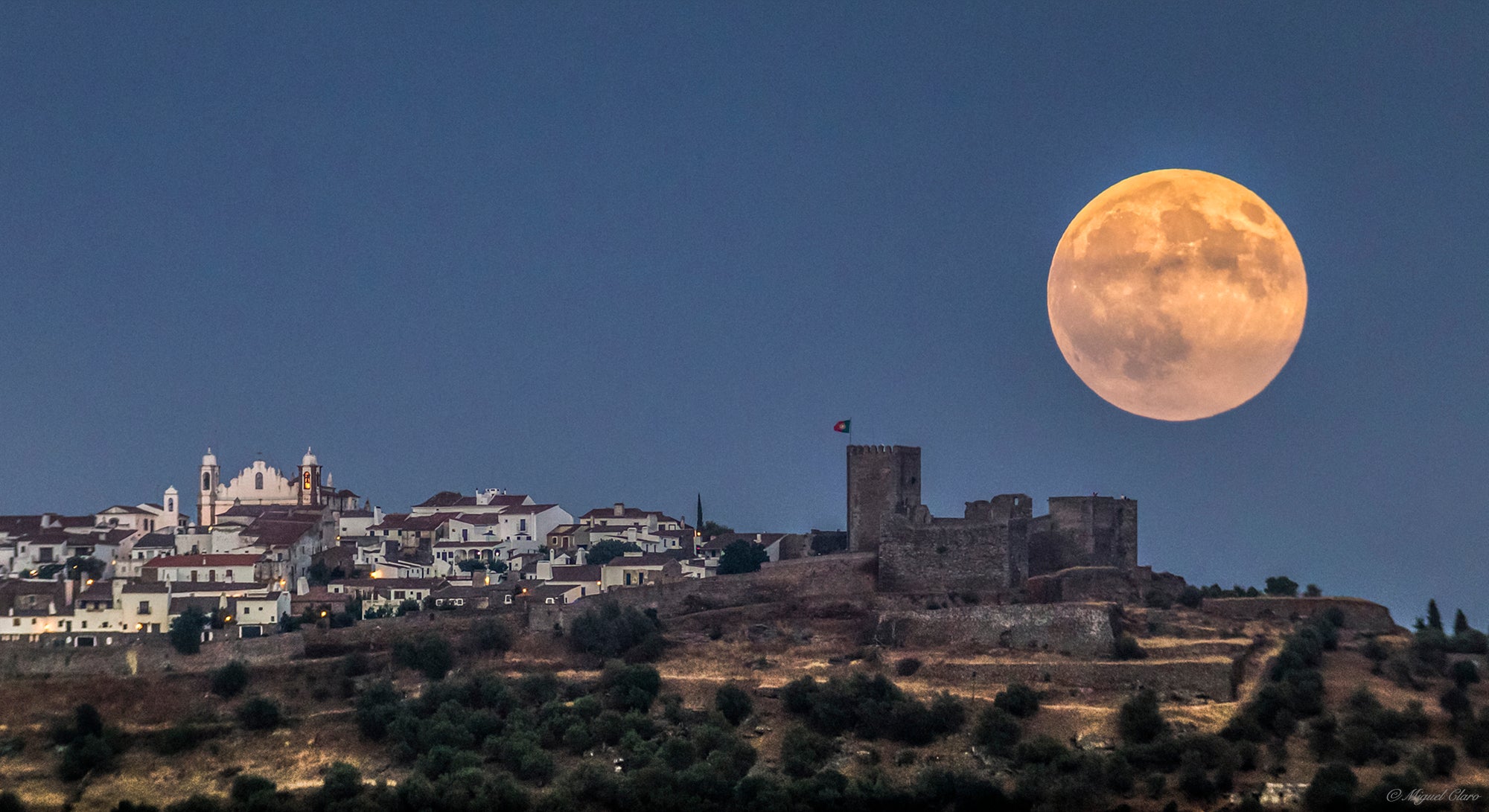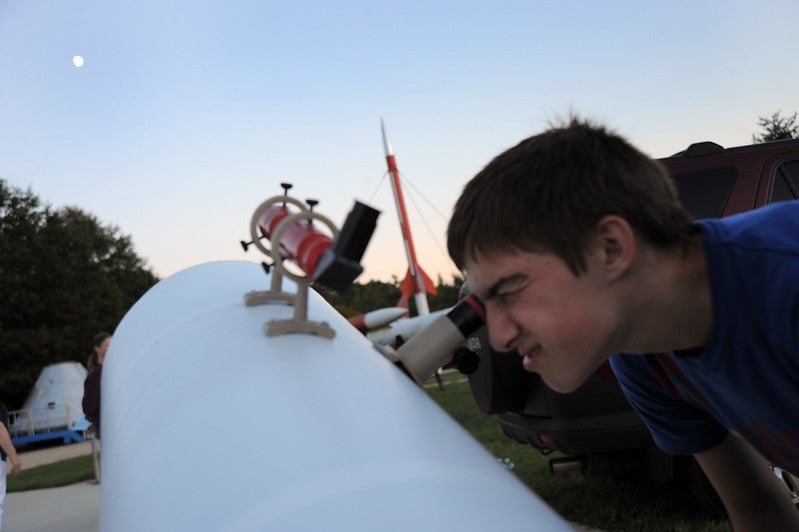
On August 30, a cosmic confluence of events will impact the Full Moon. Step outside after sunset and you’ll notice a big, bright Blue Super Moon.
What do all those terms mean? Let’s break it down.
First, the Moon reaches perigee at 11:54 A.M. EDT Wednesday morning. Perigee is a term for the closest point to Earth in our satellite’s orbit, which is not perfectly circular. So, it sometimes sits closer to Earth than others. (Apogee is the opposite term, for the farthest the Moon is from Earth each orbit.) At that time, Luna will sit just 221,942 miles (357,181 kilometers) away — nearly 17,000 miles (2,736 km) closer than its average distance of 238,855 miles (384,400 km).
Then, just a few hours later, the Moon reaches Full at 9:36 P.M. EDT. This is the crucial moment, as this Full Moon is special for two reasons.
First, because the Full phase occurs so closely after the Moon reaches perigee, it is considered a Super Moon. By “closely,” astronomers require the Full Moon to occur within 90 percent of perigee, so a Super Moon can be either shortly before or shortly after perigee.
And second, because this is the second Full Moon within a single month — the last Full Moon occurred August 1, called a Sturgeon Moon — this Full Moon is called a Blue Moon. This term is used for any second Full Moon to take place in a calendar month.
What will the Super Moon look like?
In astronomy, distance affects how large something appears in the sky. The average Full Moon subtends about 31′, or roughly half a degree. But when the Moon is closer or farther than average, it naturally appears — very slightly — larger or smaller than average as well, respectively. As it’s rising on the 30th, the Moon will appear roughly 33.5′ across, or 8 percent larger than average. To the human eye, that small difference indistinguishable, so the Moon won’t appear any bigger than usual.
What you may notice is something often seen with any given Full Moon, which always rises from the horizon around the time of sunset: The rising Moon can appear huge while near the horizon, then seems to shrink as it gets higher in the sky! This is often called the Moon illusion and is due in part to the fact that your brain has objects of known size to compare the Moon with while it is near the horizon. Once the Moon climbs high enough, it sits alone in the sky and thus appears smaller. Be on the lookout around sunset to see if you notice the big, bright face of the Full Moon on your eastern horizon.
Distance and angular size play a role in how bright the Super Moon will appear. Because it is marginally larger and closer, a Super Moon’s light (remember, the Moon doesn’t generate light and instead simply reflects incident sunlight) can appear slightly brighter. A Super Moon can look some 14 to 16 percent brighter than a normal Full Moon and several times beyond even that than a Full Moon at apogee, when our satellite appears smallest and is farthest away. That change in brightness is still small, but it might be enough to ping your awareness that something is slightly different about the Moon as it traverses the sky this week.

How to view the Blue Super Moon
Looking at the Full Moon is one of the easiest astronomical observations you can undertake — you don’t need anything but your eyes! Anyone can look out the window or step outside to enjoy the bigger, brighter Full Moon on Wednesday.
If you’re in a dark location with minimal artificial lighting, notice how the Moon’s light is bright enough to cast shadows (this is true of any Full Moon, so you can observe this effect any time one is in the sky). Looking at Luna’s bright face, you’ll notice big, round darker patches — these are lunar seas, or maria, which were not filled with water but are composed of cooled lava from our satellite’s formative past.
More advanced observers may want to turn binoculars or a telescope on the Moon. Note that it will appear exceptionally bright under magnification — your eyes may water and it will definitely ruin your night vision, so only turn to the Moon after you’ve done any observing that requires better dark adaptation. To cut down on the glare, you can increase the magnification (which gives you a smaller field of view, and thus less area to reflect light), use a Moon filter, or even wear sunglasses while sitting at your scope.
Below are the approximate times of sunrise, sunset, moonrise, and moonset — note these times will differ slightly by location.
Sunrise: 6:26 A.M.
Sunset: 7:35 P.M.
Moonrise: 7:49 P.M.
Moonset: 5:35 A.M.
Moon Phase: Full
*Times for sunrise, sunset, moonrise, and moonset are given in local time from 40° N 90° W. The Moon’s illumination is given at 12 P.M. local time from the same location.
2023’s spate of Super Moons
You may have noticed the term Super Moon has popped up a lot this year. That’s because 2023 has now hosted three Super Moons so far — and there’s one more still to come! The next Full Moon on the morning of September 29 is also a Super Moon, coming soon after our satellite reaches perigee late in the evening on the 27th.
2023’s Super Moons occurred in July, August (twice!), and September. This run of Super Moons is due to the fact that the Moon’s orbital or sideral period of 27.3 days happens to have lined up with its synodic period, or the time it takes to go from New Moon to Full Moon to New Moon again, which is 29.5 days. Essentially, the two periods have fallen briefly in sync, but will diverge enough after September’s Full Moon that the Full phase won’t occur near perigee again for another year and a half or so.
How does this work? Think of sitting in your car in the turn lane, waiting for the light to change. If you watch your blinker light on the dash and the rear blinker of the car in front of you, you’ll notice that sometimes they blink at exactly the same time for a short while, then slowly start to flash at different times until one turns on when the other is turning off. This is what’s happening with the two lunar periods as well.
That lunar month of 29.5 days also affects how often a Blue Moon occurs in much the same way. These events are much rarer — this is 2023’s only Blue Moon, as every other month of the year hosts only a single Full Moon. The next Blue Moon won’t occur until May 2026.
So, get out there and enjoy the moonlight!









